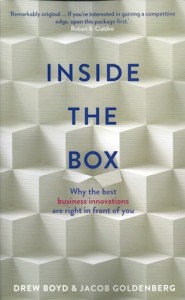The one-sentence summary
Thinking outside the box is usually impractical – inside the box is where practical and exciting innovation lies.
WHAT THE BOOK SAYS 
· So-called “outside the box’ thinking usually only generates crazy out-there solutions that mainly don’t work in the real world.
· The best business innovations are right in front of you.
· Creativity can be taught. It’s practical thinking, not divine inspiration that causes innovation.
· Systematic Inventive Thinking offers five different ways to get a result:
1> Subtraction: list the product’s main components; remove an essential one, partially or fully; visualise the result (no matter how strange); ask what are the potential benefits or new markets for the new version.
2> Division: list the components; divide the product functionally or physically; visualise the new version; look for benefits and markets.
3> Multiplication: make the list; make copies of a component; change one of the essential attributes of the copy; visualise and look for benefits.
4> Task Unification: give a component an additional task, either internal or external; look for new benefits.
5> Attribute Dependency: work out what is dependent on what else (this is much more complicated).
WHAT’S GOOD ABOUT IT
· Function follows form works best. Start with the solution and then find the best configuration (the old ‘form follows function’ was invented by the architect Louis Sullivan in 1896).
· Since Alex Osborn (the O in BBDO) invented brainstorming in 1953, most studies have shown that they don’t actually work very well:
~ There is no advantage to brainstorming in a group over those same people working alone.
~ Brainstorms come up with fewer ideas than those people working alone.
~ The quality and creativity of group ideas is lower.
~ The optimal number of people in a brainstorm is four (not “the more the merrier.”)
· Structural and functional fixedness prevent people seeing what might be possible because they are too anchored in what currently happens.
· Try listing each stage in a process on as post-it note and moving them around to increase ease, logic, or customer experience.
· Mental practice produces two-thirds of the benefits of practical practice, so it’s worth concentrating hard on things you want to learn –such as creativity and innovation.
WHAT YOU HAVE TO WATCH
· At last. A book that echoes what I have been saying for years. Smart answers come better when subject to severe practical constraints.
